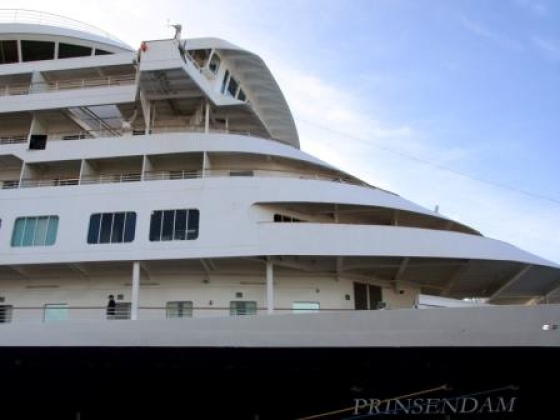Only a few branches separated us from arriving here this morning or being stuck 300 miles downriver. Yesterday, just before sundown, the ship vibrated top to bottom and the engines seemed to shriek. After ten minutes the captain explained in a calm manner, that they thought a big log had been sucked under the hull and might be stuck in the propellers. He was going to stop the vessel and have a look. Personally I didn’t “see” – so to speak – how anyone could have a look in or through this brown-yellowish, opaque Amazon brew. Within half an hour he had it all solved by maneuvering the ship, just like we bob our car when it is stuck in mud or snow: full reverse, and forward, three times and … all systems go!
Before we were to arrive in Manaus, the 2nd encounter of the waters was programmed at 7am. The Rio Negro, tumbling down from the North, joins the Amazon main river 12 miles before Manaus. The Negro has ink black water (due to lack of oxygen and special compounds) and the two liquids do not mix readily. Only after ten kilometers of flowing “decreasingly alongside each other” do they become one stream: a brown-yellowish soup, of course.
All told, I didn’t consider it as spectacular as the confluence of the Amazon with the blue Tapajos in Santarèm. The compensation for this half disappointment came as a steamraincloudburst, , until today, unseen by me. In less than ten minutes the decks were covered by 1 inch of water, and you couldn’t see the fingers of your outstretched hand. A primordial deluge it was! That didn’t impede our subsequent docking at the Manaus floating dock, on time.
I had planned a visit of the city today, partly guided and partly by myself. From all angles this is, in summary, a jungle metropolis, twice over. The city itself is an unabridged jungle while, at its outskirts, in whatever direction you choose to look, you find enormous green-walled freshwater flats that hurry, very slowly, towards the far away sea. There is no escaping the infinite expanse of this unimaginable landscape. In the city though you cannot escape the dirtiness, the disorder, the noise (sometimes disguised as samba music), and in some sections the utter poverty … The operahouse and four buildings, dating back to the late 19th century are the only bright spots.
 To round it out then, a few factoids from our guide: Manaus has just under 3 million inhabitants in a city area of about 4200 square miles (11000 km²). There is NO soccer stadium anymore because they are building a new one with 40000 seats for the FIFA 2014 World Cup. Note though that the biggest stadium in Manaus rises to 130ft high and “seats” 200000 fans, as long as they stand up! That happens one day a year at Carnival, for the Samba Dancers Parade. He added that they also organize, since a few years, a Gay Parade, on the following day, which he described as “Asswednesday”. Finally, by road Manaus is only connected to Venezuela. The highway is 1400 miles long and runs due North. It takes 48 hours to reach the border and it is dotted with fifteen police checkpoints against drug and weapons trade. If you want to travel in other directions from Manaus, you may choose between planes and boats. For short: it is a big hole in the wilderness, with a few pearls that emphasize the size of the hole!
To round it out then, a few factoids from our guide: Manaus has just under 3 million inhabitants in a city area of about 4200 square miles (11000 km²). There is NO soccer stadium anymore because they are building a new one with 40000 seats for the FIFA 2014 World Cup. Note though that the biggest stadium in Manaus rises to 130ft high and “seats” 200000 fans, as long as they stand up! That happens one day a year at Carnival, for the Samba Dancers Parade. He added that they also organize, since a few years, a Gay Parade, on the following day, which he described as “Asswednesday”. Finally, by road Manaus is only connected to Venezuela. The highway is 1400 miles long and runs due North. It takes 48 hours to reach the border and it is dotted with fifteen police checkpoints against drug and weapons trade. If you want to travel in other directions from Manaus, you may choose between planes and boats. For short: it is a big hole in the wilderness, with a few pearls that emphasize the size of the hole!
Tomorrow I escape to …. the jungle, on the Rio Negro, by boat – which, in the neck of these woods, is the beginning and the end of all things!
Prinsendam, Day 12 – Sunday Jan16th, 2011, 1800hrs
From a gaping hole in the imposing Amazon jungle


Ik ben tot de conclusie gekomen dat de Prinsendam een speedboot op steroïden is. Het doet mij denken aan “Roger”, de klusjesman van de televisie, die op tien minuten tijd een badkamer neerpoot, een hondenhok timmert, de zolder voorziet van twintig centimer isolatie en tussendoor een warmtewisselaar plaatst. Als het zo verder gaat wordt de trip Atotdevijftiende….
Een verzoekje… kan je wat foto’s maken van het notoire crow’s nest. Doet me denken aan Hemingway 🙂
Veel plezier in de Jungle!